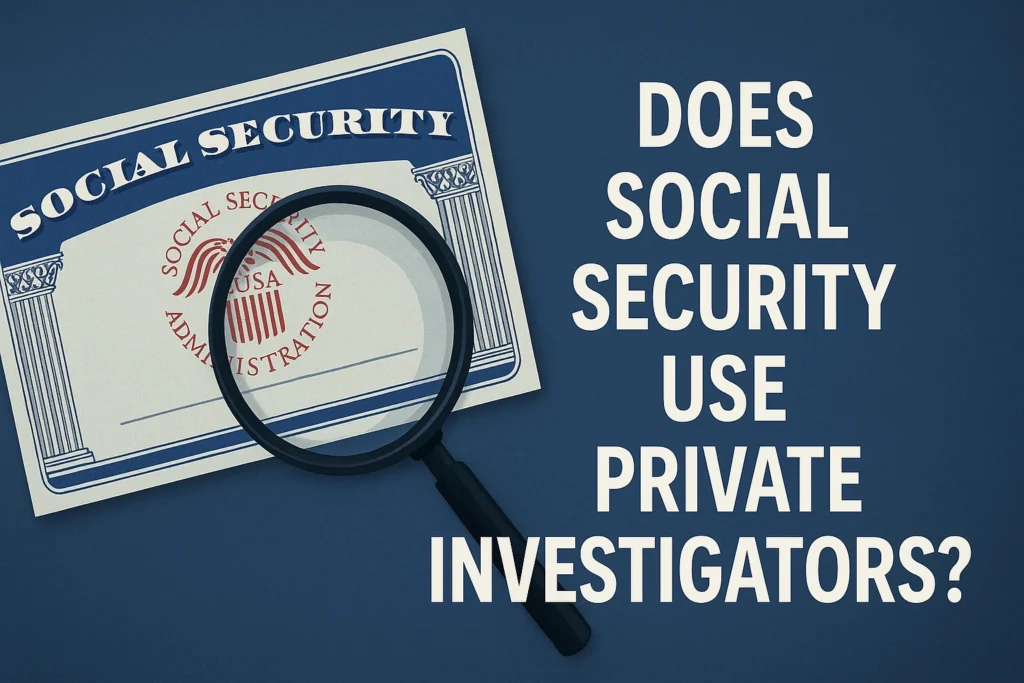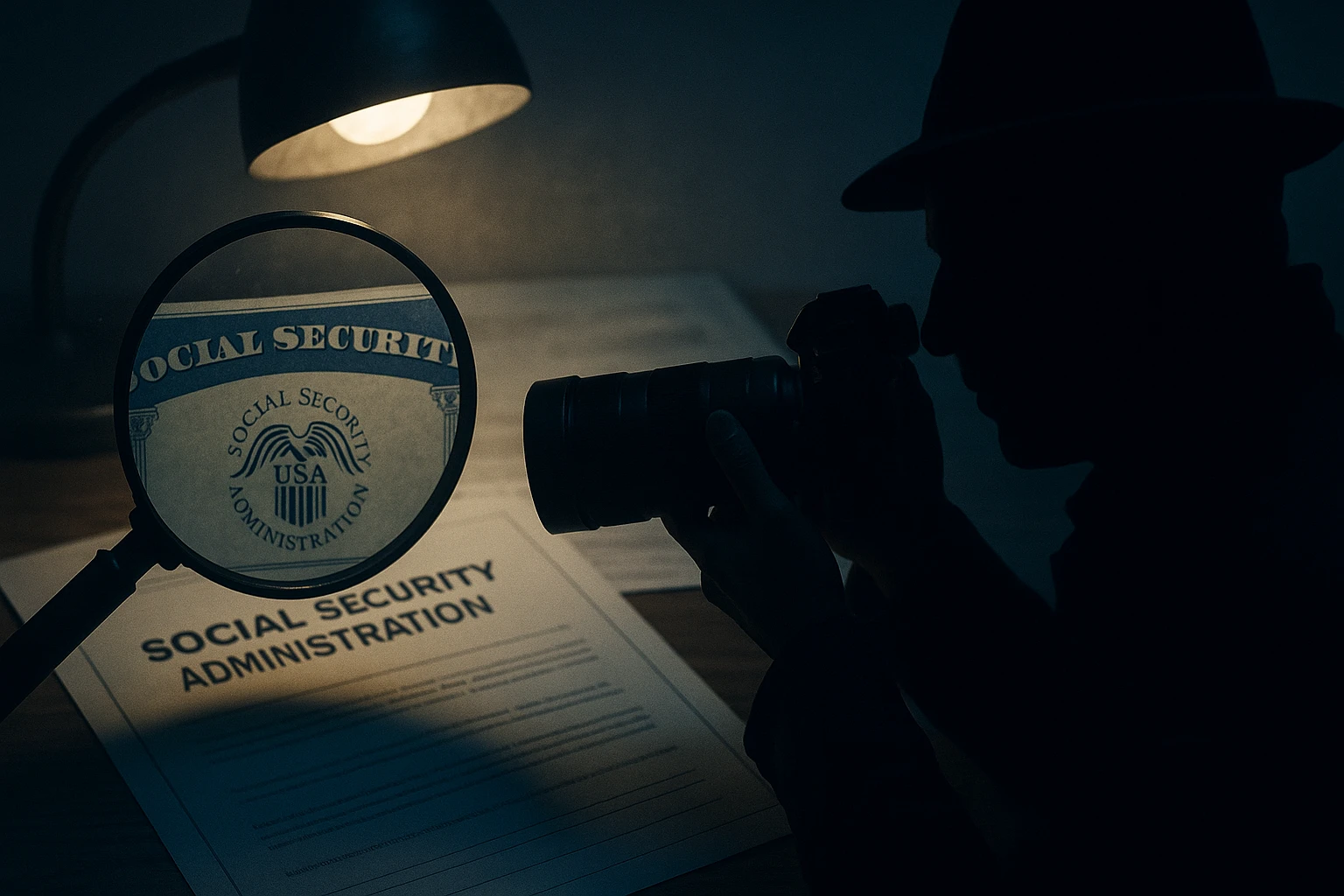Many disability applicants worry that a private investigator hired by the Social Security Administration (SSA) will be lurking outside their home, filming every movement. That fear is understandable—your claim file contains intimate details about your health problems, and nobody likes feeling like the subject of an investigation. The truth, however, is more nuanced than late-night rumors and viral TikToks suggest. Below you’ll learn exactly when and why Social Security may open a fraud investigation, what kinds of surveillance tactics are on the table, and how to keep your claim on track.
Key points
- The SSA rarely assigns private investigators to ordinary disability claims; the practice is reserved for red-flag cases involving suspected disability fraud or misconduct.
- Most monitoring happens on paper—through medical records, function reports, and scheduled Continuing Disability Reviews (CDRs)—not through video surveillance or GPS trackers.
- The agency unit handling fraud is the Office of the Inspector General (OIG), often working with other law-enforcement bodies such as the Department of Justice.
- Publicly available social media accounts are fair game; social media reviews can trigger deeper inquiries if your posts contradict your claimed limitations.
- If you receive a call or visit from an SSA or OIG investigator, remain courteous, verify the agent’s ID, and contact an experienced Social Security disability lawyer for a free consultation before sharing more than basic facts.

Debunking the Big Myths About SSA Surveillance
1. “Everyone who files for disability gets followed.”
False. The SSA processes millions of applications each year and simply lacks the manpower—or the budget—to tail every applicant with a team leader, police officer, and camera crew. The disability system focuses its limited investigative resources on:
- Tips alleging that someone is working “under the table.”
- Evidence that a claimant provided a fake Social Security number (SSN) or altered earnings records.
- Unusual patterns inside the program—say, a spike of approvals coming from the same local office or a single medical professional.
2. “The procedure manual says they can watch me anytime.”
Nope. The SSA’s Program Operations Manual System (POMS) does not authorize routine daily surveillance. It emphasizes background checks, document reviews, and medical verification. Field agents must justify any direct observation in writing, stating why less-invasive tools won’t work.
3. “If they do investigate, they hire random bounty hunters.”
Investigations are handled by credentialed federal employees—the OIG’s disability investigators—sometimes partnering with state law enforcement or federal prosecutors. They may subcontract licensed private citizens (investigators) for specialized tasks, but those contracts are tightly controlled.
When Does Social Security Use Private Investigators?
Fraud Hot Spots
- Representative payee misuse (a relative cashing your checks).
- Staged injuries or forged medical records.
- Collusion rings—like the infamous West Virginia scandal where a high-volume attorney, an administrative law judge, and a doctor rubber-stamped hundreds of cases for hefty fees.
In such files, the OIG may employ undercover surveillance, hidden-camera footage, or even criminal prosecution. But again, these are periodic reviews targeting obvious outliers, not routine practice.
Continuing Disability Reviews (CDRs)
Every three to seven years—or sooner if the SSA labels your case “Medical Improvement Expected”—you’ll face a Continuing Disability Review. Think of it as a health check-up for your benefits:
- You complete updated function reports.
- Doctors submit fresh treatment notes.
- A claims analyst cross-checks everything against your original claim file.
Only if something glaring appears—say, public Facebook photos of you rock-climbing two weeks after a spinal-fusion surgery—might the agency green-light a criminal investigation.
How Social Security Monitors Without a Tail
| Monitoring Tool | What It Looks For | Why It Matters |
|---|---|---|
| Medical Evidence Evaluation | Objective scans, lab tests, surgical reports | Confirms the severity of your limitations |
| Third-Party Statements | Letters from friends, employers, members of the public | Corroborates how your condition limits daily activities |
| Social Media Reviews | Pictures, reels, location tags | Detects inconsistencies with claimed restrictions |
| FOIA Requests | Your right to obtain agency notes | Lets you see what the SSA sees in your official website file |
Digital Footprints: The Use of the Internet in Disability Claims
The SSA’s analysts routinely Google applicants’ names, scan public Instagram reels, and scroll through TikTok or X. While they rarely log in under false pretenses, anything posted publicly—or shared by a friend who hasn’t locked down privacy settings—can be saved to the investigation process.
Photos of heavy lifting? That can be a red flag.
Check-ins at a marathon? Another wrong impression that warrants follow-up.
Keeping your profiles private, avoiding strenuous activities, and ensuring you are not tagged without permission are all ways to stay safe.
Protecting Your Claim—Best Practices
- Be Consistent. Make sure your social security disability application, doctor’s notes, and online presence tell the same story.
- Keep Records. Store every piece of medical evidence, pay stub, and letter in a single folder. Requested faster? You’ll have it.
- Consult a Pro. An experienced Social Security disability lawyer can flag gaps, prepare you for periodic reviews, and represent you if a criminal defense becomes necessary.
- Know Your Rights. You may request, under the Freedom of Information Act (FOIA), copies of surveillance photos or memos that influence your case.
- Stay Calm if Contacted. Investigators must identify themselves. Take notes, ask for their agency ID, and schedule that free consultation—the safest way to handle any official inquiry.
Conclusion: Facts Over Fear
Most applicants will never see a private investigator parked outside their home, and the SSA is far more interested in solid medical documentation than clandestine stakeouts. Focus on honest storytelling, robust evidence, and responsible online behavior. If you hit a snag—or receive an unexpected knock—remember that federal rules, experienced attorneys, and common sense all exist to keep the disability system fair.
FAQ
Will the SSA hire investigators to watch me 24/7?
Only in isolated fraud investigations—a fraction of one percent of total cases. Routine claims proceed through paperwork, not undercover ops.
Can the agency use video surveillance or GPS trackers without telling me?
Technically possible but extraordinarily rare; it requires written justification and, often, a court order.
What is a Continuing Disability Review, and could it stop my checks?
A CDR is a scheduled review of your medical status. If evidence shows significant improvement, benefits may cease—but you have appeal rights.
Could my public Facebook photos hurt my case?
Yes. If images contradict reported limitations, they may be saved as evidence.
How do I respond to an unexpected call from an SSA investigator?
Verify the caller’s identity, remain polite, and contact an experienced Social Security disability lawyer before providing detailed statements.
Is there anywhere I can read the agency’s own rules?
Yes—the POMS and other procedural guides are posted on the SSA’s official website. You can also submit a FOIA request for your specific file.
By following these guidelines, you’ll minimize risks and maximize your chances of securing—and keeping—the Social Security disability benefits you deserve.
Disclaimer: This post is for educational purposes only and is not financial, legal, or tax advice. Do your own research or consult a qualified professional before making any decisions.
Affiliate Disclosure: GetJoeMoneyRight.com is a participant in the Amazon Services LLC Associates Program, an affiliate advertising program designed to provide a means for sites to earn advertising fees by advertising and linking to Amazon.com and affiliated sites.

